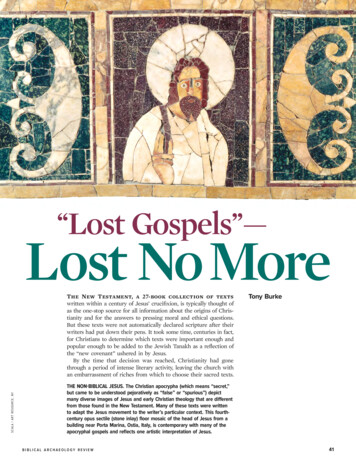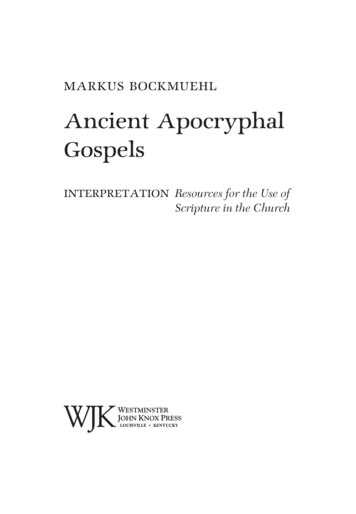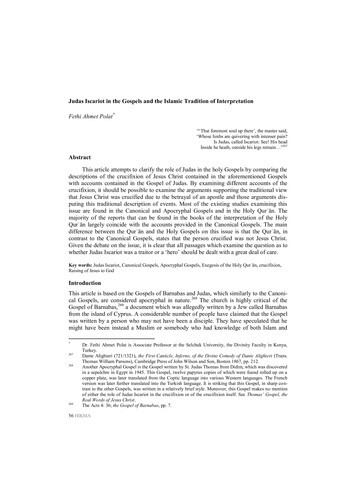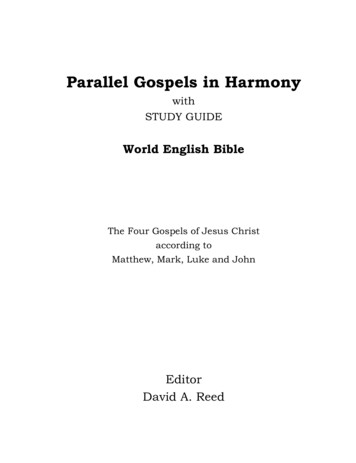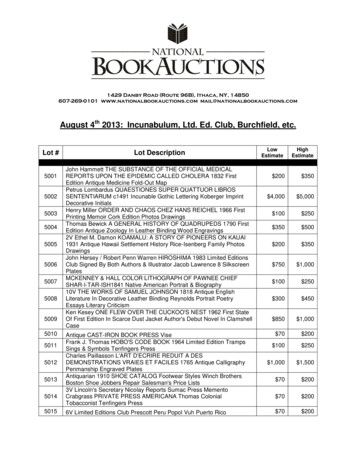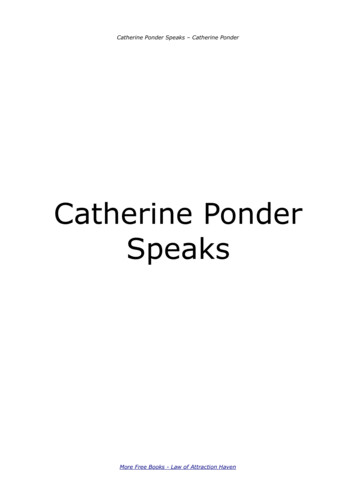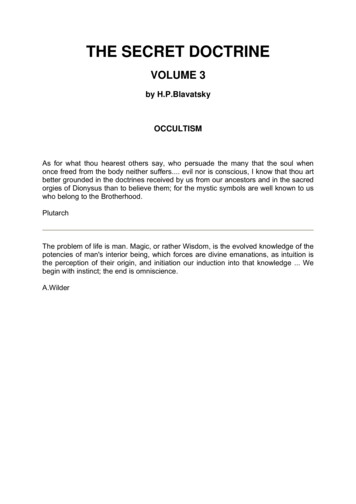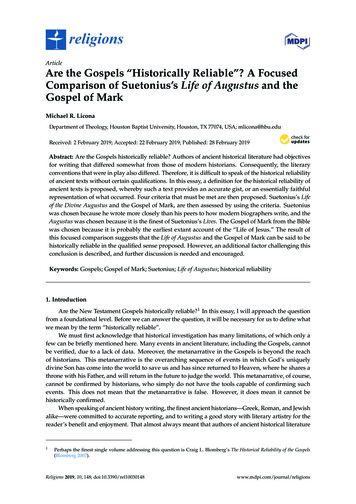
Transcription
religionsArticleAre the Gospels “Historically Reliable”? A FocusedComparison of Suetonius’s Life of Augustus and theGospel of MarkMichael R. LiconaDepartment of Theology, Houston Baptist University, Houston, TX 77074, USA; mlicona@hbu.eduReceived: 2 February 2019; Accepted: 22 February 2019; Published: 28 February 2019 Abstract: Are the Gospels historically reliable? Authors of ancient historical literature had objectivesfor writing that differed somewhat from those of modern historians. Consequently, the literaryconventions that were in play also differed. Therefore, it is difficult to speak of the historical reliabilityof ancient texts without certain qualifications. In this essay, a definition for the historical reliability ofancient texts is proposed, whereby such a text provides an accurate gist, or an essentially faithfulrepresentation of what occurred. Four criteria that must be met are then proposed. Suetonius’s Lifeof the Divine Augustus and the Gospel of Mark, are then assessed by using the criteria. Suetoniuswas chosen because he wrote more closely than his peers to how modern biographers write, and theAugustus was chosen because it is the finest of Suetonius’s Lives. The Gospel of Mark from the Biblewas chosen because it is probably the earliest extant account of the “Life of Jesus.” The result ofthis focused comparison suggests that the Life of Augustus and the Gospel of Mark can be said to behistorically reliable in the qualified sense proposed. However, an additional factor challenging thisconclusion is described, and further discussion is needed and encouraged.Keywords: Gospels; Gospel of Mark; Suetonius; Life of Augustus; historical reliability1. IntroductionAre the New Testament Gospels historically reliable?1 In this essay, I will approach the questionfrom a foundational level. Before we can answer the question, it will be necessary for us to define whatwe mean by the term “historically reliable”.We must first acknowledge that historical investigation has many limitations, of which only afew can be briefly mentioned here. Many events in ancient literature, including the Gospels, cannotbe verified, due to a lack of data. Moreover, the metanarrative in the Gospels is beyond the reachof historians. This metanarrative is the overarching sequence of events in which God’s uniquelydivine Son has come into the world to save us and has since returned to Heaven, where he shares athrone with his Father, and will return in the future to judge the world. This metanarrative, of course,cannot be confirmed by historians, who simply do not have the tools capable of confirming suchevents. This does not mean that the metanarrative is false. However, it does mean it cannot behistorically confirmed.When speaking of ancient history writing, the finest ancient historians—Greek, Roman, and Jewishalike—were committed to accurate reporting, and to writing a good story with literary artistry for thereader’s benefit and enjoyment. That almost always meant that authors of ancient historical literature1Perhaps the finest single volume addressing this question is Craig L. Blomberg’s The Historical Reliability of the Gospels(Blomberg 2007).Religions 2019, 10, 148; ons
Religions 2019, 10, 1482 of 18reported in a manner which was less concerned with precision than with the standards held by modernhistorians. Yet, even modern historiography often involves artistic license.The movie Apollo 13 (Howard 1995) was praised for its commitment to historical accuracy.Notwithstanding, director Ron Howard exercised some artistic license.2 For example, when theactual Apollo 13 spacecraft ran into multiple life-threatening difficulties, flight director Gene Kranzand his team at Mission Control never gave up and produced solutions that brought the astronautshome safely. Kranz’s firm assertion, “Failure is not an option”, became the unforgettable tagline for themovie. However, the “historical Kranz”, you might say, never uttered those words. Instead, they wereassigned to him by the scriptwriters, who had learned from Kranz and others that this was a creed atNASA’s Mission Control.3 Those scriptwriters had less than two-and-a-half hours to tell the story ofevents that spanned six days. Now, this is good writing, and it is an accurate portrayal of Kranz andhis team, though not in a precise sense.The first book, written by my late friend Nabeel Qureshi, was a New York Times best seller: SeekingAllah, Finding Jesus (Qureshi 2014). It is an autobiography of his journey from Islam to Christianity.Here is what Nabeel wrote in the introduction:By its very nature, a narrative biography must take certain liberties with the story it shares.Please do not expect camera-like accuracy. That is not the intent of this book, and to meetsuch a standard, it would have to be a twenty-two-year-long video, most of which wouldbore even my mother to tears.The words I have in quotations are rough approximations. A few of the conversationsrepresent multiple meetings condensed into one. In some instances, stories are displaced inthe timeline to fit the topical categorization. In other instances, people who were present inthe conversation were left out of the narrative for the sake of clarity. All of these devices arenormal for narrative biographies . . . Please read accordingly. (Qureshi 2014, p. 19)This is a biography written in the 21st century by a meticulous academic.4 Biographers in antiquityused those types of devices and others. In my view, this does not undermine the overall reliability ofthe literature, as long as we have the understanding that what we are reading was intended to conveyan accurate gist, or an essentially faithful representation of what occurred. Ancient historical literaturerarely ever intended to describe events with the precision of a legal transcript.5Sallust commanded one of Caesar’s legions, and he would become one of Rome’s finest historians.Tacitus referred to Sallust as “that most admirable Roman historian” (Annales 3.30), while thefamous rhetorician Quintilian said Sallust was a greater historian than Livy and that “one needsto be well-advanced in one’s studies to appreciate him properly” (Institutio oratoria 2.5.19). So, it isnoteworthy that Sallust occasionally displaced statements and speeches from their original context,and transplanted them in a different one, in order to highlight the true intensity, and even the truenature of those events. The finest ancient historians commonly used this technique, and others. In my2345See the Apollo 13 DVD special features on Disc 1, “Lost Moon: The Triumph of Apollo 13,” including feature commentarywith director Ron Howard and feature commentary with Jim and Marilyn Lovell (Howard 1995). The 1995 motion picture isbased on the book Lost Moon: The Perilous Voyage of Apollo 13 by Jim Lovell and Jeffrey Kluger (Lovell and Kluger 1994).In his autobiography, Kranz (2000, p. 12) describes the Mission Control team’s efforts to formulate “workaround” optionsduring the Apollo 13 flight: “These three astronauts were beyond our physical reach. But not beyond the reach of humanimagination, inventiveness, and a creed that we all lived by: ‘Failure is not an option.’” Several years ago, one of the NASAengineers who was on Kranz’s team approached me after a lecture and told me something to the same effect. Moreover,Jerry C. Bostick, who was NASA’s flight dynamics officer for Apollo 13, offers a similar explanation for how the sayingbecame the tagline of the film, which had to do with something he said in passing to the same effect while he was beinginterviewed by the scriptwriters (Woodfill 2019).Although Seeking Allah, Finding Jesus was a book written for a popular audience, Qureshi earned an MPhil in Judaism andChristianity in the Greco-Roman World from Christ Church, University of Oxford. He had just been accepted into the DPhilin New Testament program when he learned he had stage four stomach cancer. Nabeel died in 2017 at the age of thirty-four.Of course, artistic license has its limits. And some authors went so far that what they wrote could not be considered“historically reliable” apart from dying the death of a thousand qualifications.
Religions 2019, 10, 1483 of 18view, that does not undermine the overall reliability of the literature in which they appear, as long as wehave the understanding that what we are reading was most often intended to convey an accurate gist ofthe people and events described, rather than preserving details with the precision of a court transcript.We may think about historical reliability in two ways: specifically and broadly. Many of us havechosen to get our news from a particular network. Those who live in the United States and havepolitical leanings to the right, usually view FOX, while those with political leanings to the left areinclined to view CNN or the other mainstream media. One can focus on specific stories reported bytheir preferred news agency and assess whether a story is true, false, mostly true, or mostly false.Alternatively, one can assess that news agency on a broader basis. Regardless of the news agency thatone chooses, viewers know that every agency is biased and is select in its reporting. Despite thesedeficiencies, viewers may still assess their preferred news agency as being generally reliable.Classicists who understand the objectives of ancient historians do not usually speak of a textas being “historically reliable” in the broad sense. For example, though Tacitus is regarded as beingamong the most accurate of Roman historians, it would be rare to find a classicist saying that theliterature that Tacitus wrote is “historically reliable”. Instead, classicists focus on the specific reportsof an author, such as whether it was Curio or Antony who presented Caesar’s counterproposal tothe senate in December 50 BCE, over the actual day on which the counterproposal was delivered.In contrast, while historians of Jesus debate over the reliability of specific reports in the Gospels,such as whether Jesus actually claimed to be divine or had predicted his resurrection, it is also the casethat some of them speak in the broader sense of the Gospels being historically reliable. It is also in thisbroader sense that this essay is concerned.I will begin by proposing a tentative definition for the term ‘historically reliable’, as follows: A textmay be regarded as historically reliable when it provides an accurate gist or an essentially faithfulrepresentation of what occurred. In what follows, I will offer four criteria, all of which must be metbefore one is justified in claiming that a text is historically reliable in a broad sense. Some of thesecriteria may need to be nuanced or abandoned, and additional criteria may be required. What followsin this essay is simply an initial attempt.In proceeding, I will employ these criteria to assess Suetonius’s Life of the Divine Augustus andthe Gospel of Mark. I chose Suetonius because he wrote more closely to how modern biographerswrite. than did others in his day. Others relied on their use of rhetoric to impress and persuade as theytold a good story. Suetonius did not, at least not in the same manner and to the same degree. AndrewWallace-Hadrill (Wallace-Hadrill 1995, p. 19; cf. 18, 23–24) writes,He is mundane: has no poetry, no pathos, no persuasion, no epigram. Stylistically he hasno pretensions. No writer who sees himself as an artist, one of the elect, could tolerate thepervasive rubric; the repetitiveness of the headings, the monotony of the items that follow,the predictable ending “such he did; and such he did; and such he did”. Suetonius is notsloppy or casual; he is clear and concise, but unadorned. His sentences seek to inform, with aminimum of extraneous detail . . . The style is neither conversational nor elevated. It is thebusinesslike style of the ancient scholar.6Mellor (1999, p. 149) similarly comments, “Unlike the historians of antiquity, Suetonius is notprimarily a literary artist; he is the ancestor of the modern scholar”.7I have chosen to focus on Suetonius’s Life of Augustus, because it is his finest biography. Suetoniuswas most interested in the transitional period of the late Republic to the early Empire. This is67Wallace-Hadrill (Wallace-Hadrill 1995) is cited by almost all subsequent literature on Suetonius, and is regarded as one ofthe most valuable treatments of Suetonius. See also Bradley (1998, p. 12), Hurley (2001, p. 19), and Tatum (2014, pp. 163–64).Wallace-Hadrill (Wallace-Hadrill 1995, p. 10) adds, “Suetonius establishes the independence of his genre by distancinghimself from history the further”.See also Power (2014, p. 13).
Religions 2019, 10, 1484 of 18understandable, since that period is not only the most interesting time for Rome, it is also oneof the most interesting times in human history. Suetonius shows knowledge of many sources forhis work, Julius and Augustus. However, his use of sources in his twelve Lives of the Divine Caesarstapers off significantly afterwards, as does the length and quality of those Lives. After Nero, Suetoniusshows little interest (Wallace-Hadrill 1995, pp. 61–62). This creates a challenge in speaking of thehistorical reliability of Suetonius’s Lives as a collection, and prompts us instead to speak of the historicalreliability of each Life.I have chosen the Gospel of Mark from the Bible, since it is very likely the earliest of the fourcanonical Gospels, with the other Synoptics using him as their primary source, and because John’sGospel presents unique challenges that require a separate discussion. Thus, it is easier to speak on thehistorical reliability of Mark, rather than the historical reliability of the Gospels as a collection.I will now turn to four provisional criteria for assessing the historical reliability of ancient historicalliterature and employ them for assessing Suetonius’s Life of Augustus and Mark’s Gospel.2. The Author Chose Sources JudiciouslyGaius Suetonius Tranquillus was born around 70 CE.8 His date of death is unknown.9 Suetoniuswrote the Lives of Illustrious Men,10 Lives of the Caesars, and some other works that have since beenlost.11 It is his Lives of the Caesars for which he is best known. Since Suetonius dedicated his Lives ofthe Caesars to the praetorian prefect Septicius Clarus, some scholars date them to the period in whichSepticius held that post: 119–122 CE.12 However, several other scholars think that Suetonius was stillwriting those Lives in the 130s.13For his Julius, and especially his Augustus in Lives of the Caesars, Suetonius outdid otherhistorians of his day in terms of naming his sources. He held three important posts in the emperor’sadministration: cultural and literary advisor to the emperor (a studiis), director of the imperial librariesof Rome (a bibliothecis), and supervisor of the emperor’s correspondence (ab epistulis). While servingin these posts, he would have enjoyed access to many valuable sources. Although those positionsafforded Suetonius unique access to some sources, scholars are not certain about which of his sourceswould not have likewise been available to others (Wallace-Hadrill 1995, pp. 91, 95; Hurley 2001,pp. 8–9).14When Suetonius wrote about emperors that were closer to his own time, he did not name manysources, if any at all. Scholars do not know why this is the case, but have often suggested that, since his891011121314For the dating of Suetonius’s birth, see Bradley (Bradley 2012, p. 1409), Edwards (2000a, p. viii), Keener (2016, p. 146),Keener, Christobiography (Keener forthcoming), who says from c. 69 CE to c. 130–140 CE; and Hurley (2001, p. 1): “he wrotein the first quarter of the second century”.Regarding the date of Suetonius’s death, Edwards (2000a, p. viii) says, “There are no further references to his career, thoughfrom a passage in Titus (chp. 10), it seems he was probably still writing after 130”. Hurley (2001, p. 4) reports much thesame: “No more is known of him after he left the court. He may have lived on for some time”. Hurley (2001, p. 4n16) notesfurther, “Suetonius seems to have written of Domitia Longina as though she had died, perhaps in the 130s (Tit. 10.2[)]”.Likewise, Van Voorst (2000, p. 29) says, “ca. 70–ca. 140” (29).Hurley (2001, p. 6) notes that Lives of Illustrious Men contains more than 100 biographies of Roman poets, orators, historians,philosophers, grammarians, and rhetoricians.Bradley (Bradley 2012).For the dating of Suetonius’s Lives of the Caesars, see Bradley (1998, p. 26); Edwards (2000a, p. viii); Keener (2016, p. 146);Keener, Christobiography (Keener forthcoming); and Van Voorst (2000, p. 30).See Hurley (2001, pp. 4, 4n16) cited earlier in note above; see also Wardle (Wardle 2014, p. 4). Therefore, the dates and thespan of time during which Lives of the Caesars was composed, is uncertain. It is certain that Suetonius’s Life of the DivineJulius was the first written of the twelve Lives. However, the order in which the other eleven were composed is not known(Hurley (2014, pp. 25–26); Edwards (2000a, p. viii)). There is also uncertainty pertaining to whether Suetonius composed theLives of Illustrious Men before his Lives of the Caesars. However, there is a tendency among today’s scholars for thinking thathis Lives of Illustrious Men was written first, perhaps as “a practice run for the Caesares” (Hurley (2001, p. 6)) and that Lives ofthe Caesars was his final writing project (Bradley (1998, p. 6)).Hurley (2001, p. 9) adds, “This does not mean, however, that he had found a cache of correspondence in a private palacearchive which only he and a select few were privileged to see. Wider access was available because earlier, in the second halfof the first century, the elder Pliny and Quintilian had seen the correspondence or parts of it, perhaps in an imperial library.Never-published papers of Julius Caesar could be found in Augustus’ libraries (Iul. 56.7)”.
Religions 2019, 10, 1485 of 18primary interest was the late Republic and its transition to Empire, his curiosities waned after thetime of Augustus. It may also be that he relied much more on oral testimony for the later emperors,since eyewitnesses would have been alive, and there would have been much common knowledgeabout those emperors. It may also be that Suetonius lacked access to the same sources after Hadriandismissed him from supervising his correspondences, or for any combination of these reasons.The most valuable sources that Suetonius consulted for his Augustus are some of Augustus’sletters, from which there are as many as twelve quotes, Augustus’s will, and the Res Gestae, Augustus’spersonal account of his accomplishments, which were written to serve as his funerary inscription.He also consulted the proceedings of the senate. Still, Suetonius does not mention his sources for muchof the Augustus. He was most likely relying on annalistic sources for most of the time.However, not all of Suetonius’s sources were of this quality. A large percentage of those hementions by name in the Augustus are either otherwise unknown, or are not the type of sourcesthat historians typically use (Wallace-Hadrill 1995, pp. 63–64). Also, scholars, such as Wardle(Wardle 2014, p. 20) suspect that most of the sources that he names actually contribute little to theportrait that Suetonius paints of Augustus. Thus, although the Augustus is Suetonius’s Life that is therichest in named sources, the majority of that Life is not based on those sources. In addition, as Wardle(Wardle 2014, p. 28) notes, Suetonius chose to use questionable anecdotes, so much so, that theAugustus may be said to be based on a combination of pristine historical sources and tabloid rumors.Gascou (1984) performed the most extensive project pertaining to Suetonius’s sources for theAugustus. After nearly 900 pages, Gascou concludes with a general observation: Suetonius consultednumerous sources, yet in an indiscriminate manner. Thus, although Suetonius was more generous innaming his sources than most other historians of his era, Plutarch was more discriminate in his choiceof sources. Did Suetonius use good judgment when choosing sources? Yes and no.Turning to Mark’s Gospel, little is known about its author. We observe that it is an anonymouswork, and that it mentions no sources. Neither should come as a surprise, however, though somescholars have made much over these observations. In a recent article, Gathercole (2018, p. 454) takesa different view to those scholars, and argues that the absence of the author’s name in the title andpreface is “entirely irrelevant to the question of the Gospels’ anonymity”. In this impressive article,Gathercole lists more than a dozen ancient historians and biographers who do not include their name inthe title or preface, in at least some of their writings.15 Of even more interest (with only two exceptions,one of which is fictitious), no ancient biographers whose writings have survived identified themselvesin the title or preface.16 We can go even further than Gathercole and note that Julius Caesar doesnot identify himself as the author of his Commentaries on the Civil War, and he writes entirely in thethird person, as the author of John’s Gospel may have done. Also, some of the most highly regardedhistorians of that era—Sallust, Livy, and Plutarch—chose not to include their names anywhere in theliterature that they wrote!Notwithstanding the common practice of anonymity in a technical sense, the ancients appearedto have known the identity of the authors who wrote these works, although in many instances, we areleft to speculate as to how they knew it. The best source attesting Plutarch’s authorship is the LampriasCatalogue, written more than a century and perhaps more than two centuries after Plutarch’s death.Additionally, it is falsely attributed to Plutarch’s son. Still, no one questions Plutarchan authorship.The traditional authorship of Mark’s Gospel is that it was written by John Mark, who wasan associate of Peter, who was one of Jesus’s three closest disciples. Evidence for the traditional1516Gathercole (2018) lists Xenophon’s Hellenica and Anabasis, Josephus’s Jewish Antiquities and The Life, Polybius, DiodorusSiculus, Arrian, Sallust, Livy, Tacitus, Florus, Philo, Plutarch, Lucian’s biographical writings, Philostratus’s Life of Apolloniusand Lives of the Sophists, and Cornelius Nepos.Gathercole (2018) identifies Lucian, Passing of Peregrinus, and the Life of Aelius in the Historia Augusta. We do not know ifSuetonius included his name in the title or preface of his Life of the Divine Julius, the first of the twelve Lives, because the firstportion of that Life has been lost.
to have known the identity of the authors who wrote these works, although in many instances, weare left to speculate as to how they knew it. The best source attesting Plutarch’s authorship is theLamprias Catalogue, written more than a century and perhaps more than two centuries afterPlutarch’s death. Additionally, it is falsely attributed to Plutarch’s son. Still, no one questionsPlutarchanReligions2019, authorship.10, 1486 of 18The traditional authorship of Mark’s Gospel is that it was written by John Mark, who was anassociate of Peter, who was one of Jesus’s three closest disciples. Evidence for the traditionalauthorshipOur earliestsource isis Papias,authorship ofof MarkMark isis muchmuch betterbetter thanthan wewe havehave forfor Plutarch’sPlutarch’s Lives.Lives. Ourearliest hose five-volume work, titled Expositions of the Sayings of the Lord, has survived only in fragmentspreservedpertaining toto hishis sources,sources,preserved inin thethe writingswritings ofof others.others. EusebiusEusebius preservespreserves Papias’sPapias’s commentscomments ation:provided below in Greek, with an English translation:Οὐκ ὀκνήσω δέ σοι καὶ ὅσα ποτὲ παρὰ τῶν πρεσβυτέρων καλῶς ἔμαθον καὶ καλῶςἐμνημόνευσα, ⸀συγκατατάξαι ταῖς ἑρμηνείαις, διαβεβαιούμενος ὑπὲρ αὐτῶν ἀλήθειαν. οὐγὰρ τοῖς τὰ πολλὰ λέγουσιν ἔχαιρον ὥσπερ οἱ πολλοί, ἀλλὰ τοῖς τἀληθῆ διδάσκουσιν, οὐδὲτοῖς τὰς ἀλλοτρίας ἐντολὰς μνημονεύουσιν, ἀλλὰ τοῖς τὰς παρὰ τοῦ κυρίου τῇ πίστειδεδομένας καὶ ἀπ αὐτῆς παραγινομένας τῆς ἀληθείας. εἰ δέ που καὶ παρηκολουθηκώς τιςτοῖς πρεσβυτέροις ἔλθοι, τοὺς τῶν πρεσβυτέρων ἀνέκρινον λόγους· τί Ἀνδρέας ἢ τί Πέτροςεἶπεν ἢ τί Φίλιππος ἢ τί Θωμᾶς ἢ Ἰάκωβος ἢ τί Ἰωάννης ἢ Ματθαῖος ἢ τις ἕτερος τῶν τοῦκυρίου μαθητῶν, ἅ τε Ἀριστίων καὶ ὁ πρεσβύτερος Ἰωάννης, οἱ τοῦ κυρίου μαθηταί,λέγουσιν. οὐ γὰρ τὰ ἐκ τῶν βιβλίων τοσοῦτόν με ὠφελεῖν ὑπελάμβανον, ὅσον τὰ παρὰζώσης φωνῆς καὶ μενούσης.“Iwillwillnotnothesitateto downset downfor alongyou, alongwithmy interpretations,everything33 “Ihesitateto setfor you,with myinterpretations,everythingI fullyremembered,guaranteeingtheirtruth.learned then from the elders and carefully remembered, guaranteeing their truth. For greatdealtosay,butthosewhomost people I did not enjoy those who have a great deal to say, but those who teach the truth.teachdidtheI truth.Nor didI enjoywhoelse’srecallcommandments,someone else’s commandments,but thoseNorenjoy thosewhorecallthosesomeonebut those who thefaithandproceedingfromthethe commandments given by the Lord to the faith and proceeding from the truth itself.4 loweroftheeldersshouldcomeif by chance someone who had been a follower of the elders should come my way, I inquiredmy way,inquiredaboutthe words Andrewof the elders—whatAndrewor orPetersaid, oror JamesPhilip ororaboutthe Iwordsof theelders—whator Peter said,or oftheLord’sdisciples,andwhateverJohn or Matthew or any other of the Lord’s disciples, and whatever Aristion and the elderAristionthedisciples,elder John,thesaying.Lord’s Fordisciples,weresaying.I did notfromthinkthatJohn,the andLord’swereI did notthinkthat itmeasmuchasinformationfromalivingandabidingwould profit me as much as information from a living and abiding voice”. (Pap., Frag.17 (Pap., Frag. 3.3–4 in Euseb., Hist. eccl. 3.39)voice”.3.3–4in Euseb.,Hist. eccl. 3.39)It appears that Papias is claiming to have received information from a disciple of the Elder John,It appears that Papias is claiming to have received information from a disciple of the Elder John,pertaining to what the Elder John was presently teaching. Scholars differ on whether Papias waspertaining to what the Elder John was presently teaching. Scholars differ on whether Papias wasclaiming that the “Elder John” is John the son of Zebedee, or a minor disciple named John who hadclaiming that the “Elder John” is John the son of Zebedee, or a minor disciple named John who hadtraveled with Jesus.18 They also differ on the dating of Papias’s writings: from the late 90s to 150 CE,traveled with Jesus.18 They also differ on the dating of Papias’s writings: from the late 90s to 150 CE,with the majority opinion of c. 130 CE.19 Even if the majority opinion is correct that Papias wrote c.with the majority opinion of c. 130 CE.19 Even if the majority opinion is correct that Papias wrote c.171817181919Reference numbers and English translation are as given in Holmes (2007, pp. 734–35).Irenaeus thought that Papias heard John the son of Zebedee directly, whereas Eusebius—perhapsReference numbers and English translation are as given in Holmes (2007, pp. 734–35).correctly—thinksPapiashave receivedinformationfrom those whohad known thattheIrenaeusthought thatthatPapiasheardwasJohnclaimingthe son oftoZebedeedirectly, knowntheapostles(Euseb.,Hist.eccl.3.39).apostles (Euseb., Hist. eccl. 3.39).Forrangeandrelativeconsensusof scholarlyopinionon the datingPapias’sBauckhamp. 14):Forthetherangeandrelativeconsensusof scholarlyopinionon 17,Bauckham“We cannot therefore date his writing to before the very end of the first century, but it could be as early as the turn of the(2017, p. 14): “We cannot therefore date his writing to before the very end of the first century, but it couldcentury”; Holmes (2007, p. 722): “within a decade or so of AD 130”; Jefford (2006, p. 37): “ca. 130”; Körtner (2010, p. 176):be asearly asthe turn ofpointsthe century”;Holmes(2007,p. 722): “withina decadeor soof AD130”;“Themajorityof scholarshipto the dateof writingas 125/130”,but Körtner(2010, paidto Eusebius’in LiberChronicorumII (frag.of2)”scholarshipin which Eusebiussuggesting(2006, p.has37):“ca.130”;Körtnernote(2010,p. 176):“The majoritypointsmakesto thestatementsdate of writingasthat Papias wrote around 110 CE; Yarbrough (1983, p. 190): “In summary, considerable evidence points to an early date125/130”, but Körtner (2010, pp. 176–77) notes that “little attention has been paid to Eusebius’ note in Liberfor Papias’ writings. The generally accepted date of 130 or later has little to commend it. We conclude that Papias wroteChronicorum2)” Hillin whichstatementsthat Papiasaround110thanCE;hisfive treatises IIca.(frag.95–110”;(2007,Eusebiuspp. 42, 48):makes“He wroteperhapssuggestingas early as about110 andwroteprobablyno laterYarbroughp. Papias190): “Insummary,evidenceaboutpointsto arly 130s (1983,. . . Sincelearnedit from considerablethe elder, this traditionMarkgoesbackdateat leasttoTheaboutthe end ofthe first centurynotorearlier”;Drobnerp. 55): “[T]heattemptsat datingworkwrote. . . rangegenerallyaccepteddate ofif130later haslittle(2007,
4 Although Seeking Allah, Finding Jesus was a book written for a popular audience, Qureshi earned an MPhil in Judaism and Christianity in the Greco-Roman World from Christ Church, University of Oxford. He had just been accepted into the DPhil in New Testament
